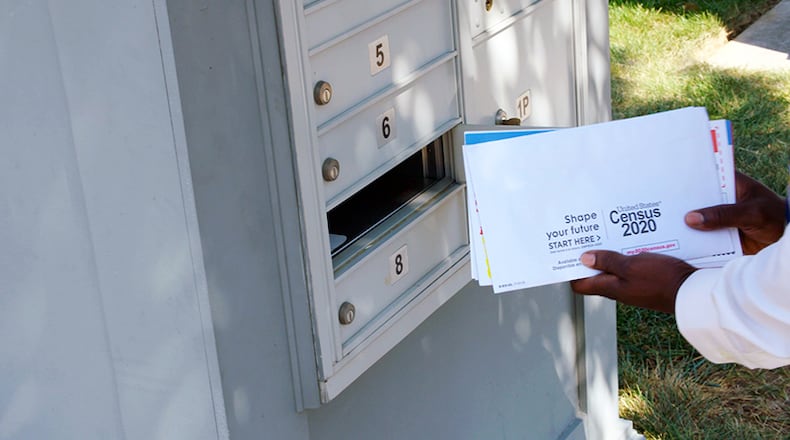However, more than 40% of us haven’t done it yet.
Come on folks turn off the video games, and stop binge watching, and get this done. Census numbers are important. They are used to determine funding and representation at state and federal levels for the next 10 years.
Provided for in the U.S. Constitution, the Census has been going on every 10 years since the beginning of this country. The first was in 1790.
Can you imagine back in 1790, watching the arrival of a man wearing a tri-corner hat, breeches, a vest and jacket, and a neckstock formally wrapped around his neck. He would look like he was going to the Fair at New Boston and he would be carrying a large legal ledger in a canvas bag or attached to his horse’s saddle as he progressed from house to house, cabin to cabin.
The census taker would speak to the head of the household, generally a man, but sometimes it was a widow. With the quill pen he would carefully write the man’s name and ask the ages of the males in the family. The numbers of males would be recorded by age categories.
READ: Springfield breweries are taking severe hit during pandemic
He didn’t want to know the ages of the females because he just needed to know how many there were. He would also ask the number of slaves, which would have been zero north of the Ohio River in the Northwest Territory.
Then he would shift some sand on the ink on the page, or blot it, and dry the words before closing the book, tipping his hat, and moving on to the next house.
In 1790 hundreds of census takers recorded the names of the thousands of Americans they met in cities, on farms, and even in lonesome cabins. I imagine it wasn’t always a pleasant situation and some folks would be reluctant to talk to a stranger. Some probably hid and were not included in the count.
Enumerators recorded the names as they sounded, guessing sometimes at the spellings of German, Dutch, French, Irish, and Swedish immigrants. There were no lines to follow so sometimes it was hard to determine where the hash marks belonged and the lines of information were not level.
Those papers still exist in the National Archives and, believe it or not, online.
They did it all again in 1800, 1810, 1820, and 1840. At first the census taker just used blank paper but later a form was printed and the census was more standardized.
Big changes occurred in the 1850 census. The names and actual ages of all members of the household were recorded. The hash marks in early census records became real people with names and their place of birth was included. Questions asked if each individual could read and write. Did the children attend school? Was the house or land owned or rented? It also asked for occupation and value of real estate.
Spelling all depended up on the skills and, I imagine, hearing ability of the enumerator and the communication skills of the person being interviewed, who may or may not have been able to read.
READ: Springfield man pleads not guilty to charges stemming from shots fired incident
Each census continued to get more complicated. There were many boxes on the grids of the form and questions that needed to be asked. How long had they been married? Do they speak English? When did you arrive in America?
In 1910 the census taker finally got an automobile to get around, although some still had horses and buggies. I imagine he had a bowler type of hat, and suspenders, but he still wore his best suit. He would look like the Wright Brothers.
The Civil War, WWI and WWII happened between censuses, so a person comparing census records would see big changes in family dynamics from before to after a war.
Census books are preserved and available online at censusrecords.com. All are available except the 1890 census, that is.
A huge fire in 1921 burned most of the 1890 census, so genealogists often have to deal with a 20-year gap in the family’s stories. It can be frustrating.
In the mid twentieth century since most of us were literate, the head of household got to fill out the forms and the information was mailed in and recorded
Collecting census information is near and dear to my heart.
During the summer of 1980, I was a Census Enumerator in Hancock County, while my husband was at sea on an aircraft carrier. While he was “haze gray and underway” off the coast of Iran, I moved back to my parent’s farm and worked for the census.
READ: Springfield restaurant celebrates 16th anniversary
I was also excited about being the person who took down the names to be recorded in the national archives. I was part of recorded history.
The U.S. Census records are a snap shot of American families from the beginning. They are a national treasure.
Don’t miss your opportunity to be listed. Your distant descendants will be looking for you. Don’t disappoint them.
As of last week 53.8% of Clark County residents have been counted. Bethel Township had 55% return the information and 59.9% of Mad River Township has responded. Moorefield Township leads the county with 71.7% responded.
In 2010 around 75% of our county was counted.
If we cannot do anything else, (and we cannot during this pandemic) maybe we can at least beat the 75% and break 80% or even 90% for the 2020 census. We can do this you know.
A hundred years from now people will find us fascinating because we did a census in the middle of the legendary COVID-19 pandemic.
Make history. Get it done.
About the Author
